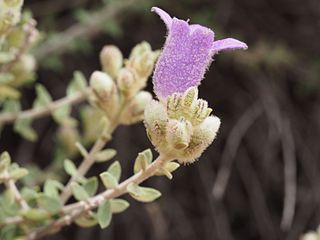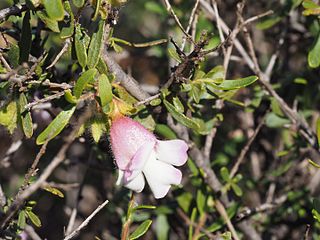
Eremophila citrina is a flowering plant in the figwort family, Scrophulariaceae and is endemic to the centre of Western Australia. It is a dense, rounded shrub with yellow new growth, crowded leaves and lilac-coloured to light purple flowers.

Eremophila demissa is a flowering plant in the figwort family, Scrophulariaceae and is endemic to a small area of central Western Australia. It is a low, spreading shrub with small, yellowish grey leaves and branches and mauve to blue flowers.
Eremophila lanata is a flowering plant in the figwort family, Scrophulariaceae and is endemic to Western Australia. It is a small shrub with small, hairy leaves, densely hairy sepals and lilac to pinkish flowers.

Eremophila magnifica is a flowering plant in the figwort family, Scrophulariaceae and is endemic to Western Australia. It is an erect shrub with large, clustered leaves and large, attractive lilac-coloured or purple flowers, sometimes so densely clustered that they appear like compound heads of terminal flowers.

Eremophila malacoides, commonly known as frontage poverty bush, is a flowering plant in the figwort family, Scrophulariaceae and is endemic to Western Australia. It is a shrub with grey-green foliage, densely hairy leaves, and usually lilac to purple flowers but a yellow flowered form also occurs.

Eremophila obovata is a flowering plant in the figwort family, Scrophulariaceae and is endemic to Australia. It is a low, compact shrub with lilac to purple flowers growing mainly in the Northern Territory and Queensland but also Western Australia, South Australia and New South Wales.
Eremophila pallida is a flowering plant in the figwort family, Scrophulariaceae and is endemic to Western Australia. It is a small, spreading shrub with hairy stems, leaves with a few serrations and reddish purple to violet flowers.
Eremophila pendulina is a flowering plant in the figwort family, Scrophulariaceae and is endemic to Western Australia. It is a tall, spindly, weeping shrub with narrow leaves and purple, mauve or white flowers in autumn and early spring.
Eremophila petrophila is a flowering plant in the figwort family, Scrophulariaceae and is endemic to Western Australia. It is a tall, erect, open shrub with rough branches, narrow, sticky leaves and pale lilac-coloured flowers.

Eremophila phyllopoda is a flowering plant in the figwort family, Scrophulariaceae and is endemic to Western Australia. It is an erect or spreading shrub, sometimes round or flat-topped with sticky, hairy leaves and flowers ranging in colour from pink or lilac to purple.
Eremophila pilosa is a flowering plant in the figwort family, Scrophulariaceae and is endemic to Western Australia. It is a small shrub with many tangled branches, with its leaves and branches densely covered with hairs and which has mauve or purple flowers. It occurs in a restricted area in the Pilbara.
Eremophila prolata is a flowering plant in the figwort family, Scrophulariaceae and is endemic to Western Australia. It is an erect shrub with a rounded top, prominently ridged, hairy branches, narrow leaves and white to deep lilac-coloured flowers.
Eremophila pungens is a flowering plant in the figwort family, Scrophulariaceae and is endemic to Australia. It is an erect, sticky shrub with broad, serrated-edged leaves which end in a sharp spine and purple or violet flowers.
Eremophila retropila is a flowering plant in the figwort family, Scrophulariaceae and is endemic to Western Australia. It is an erect, spreading shrub with hairy, greyish leaves crowded at the ends of the branches, and lilac or violet-coloured flowers which are white inside.
Eremophila revoluta is a flowering plant in the figwort family, Scrophulariaceae and is endemic to Western Australia. It is a low, dense shrub with small, hairy leaves, very hairy sepals and mauve or purple petals.

Eremophila rhegos is a flowering plant in the figwort family, Scrophulariaceae and is endemic to Western Australia. It is an erect shrub with densely hairy leaves and branches and blue, mauve, purple or white flowers.

Eremophila rigens is a flowering plant in the figwort family, Scrophulariaceae and is endemic to Western Australia. It is an erect shrub with long, stiff, glabrous leaves and pale lilac-coloured to white flowers.

Eremophila spinescens is a flowering plant in the figwort family, Scrophulariaceae and is endemic to Western Australia. It is a low, spreading, rigid, spiny shrub with small leaves and lilac to dark purple flowers.

Eremophila spuria is a flowering plant in the figwort family, Scrophulariaceae and is endemic to Western Australia. It is an erect, open shrub with narrow leaves and blue, lilac, purple or white flowers and is a common and widespread species.

Eremophila warnesii is a flowering plant in the figwort family, Scrophulariaceae and is endemic to Western Australia. It is an erect, compact shrub with furry leaves, hairy sepals and blue to mauve petals. It is a little-known species, named after the founder of the Eremophila Study Group.











